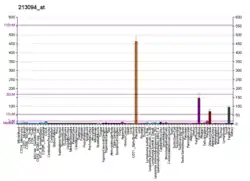GPR126
گیرندهٔ شمارهٔ ۱۲۶ جفتشونده با پروتئین جی (انگلیسی: G protein-coupled receptor 126) که با نامهای VIGR و DREG هم شناخته میشود، یک پروتئین است که در انسان توسط ژن «ADGRG6» کُدگذاری میشود.[4][5][6]
این گیرنده یکی از اعضای خانوادهٔ بزرگ «گیرندههای جفتشونده با پروتئین جی، ویژهٔ چسبندگی» است[7][8] و به میزان زیادی در سلولهای بنیادی مزانشیمی بیان میشود.[9]
یکی از کارهای احتمالی این پروتئین، دخالت در تعیین قد انسان (بهویژه اندازهٔ تنهٔ بدن)،[10][11][12] عملکرد ریوی،[13] و بروز «کژپشتی نوجوانی با علت نامشخص»[14] باشد. در موشها، این پروتئین با رشد و تکامل ستون مهرهها و غضروفهای بدن مرتبط است.[15]
علاوه بر «کژپشتی نوجوانی با علت نامشخص»، جهش در ژنِ تولیدکنندهٔ این پروتئین با بروز «آرتروگریپوزیس چندگانهٔ مادرزادی» در ارتباط است.[16]
منابع
- GRCm38: Ensembl release 89: ENSMUSG00000039116 - Ensembl, May 2017
- "Human PubMed Reference:". National Center for Biotechnology Information, U.S. National Library of Medicine.
- "Mouse PubMed Reference:". National Center for Biotechnology Information, U.S. National Library of Medicine.
- Fredriksson R, Gloriam DE, Höglund PJ, Lagerström MC, Schiöth HB (February 2003). "There exist at least 30 human G-protein-coupled receptors with long Ser/Thr-rich N-termini". Biochemical and Biophysical Research Communications. 301 (3): 725–34. doi:10.1016/S0006-291X(03)00026-3. PMID 12565841.
- "Entrez Gene: GPR126 G protein-coupled receptor 126".
- Hamann J, Aust G, Araç D, Engel FB, Formstone C, Fredriksson R, Hall RA, Harty BL, Kirchhoff C, Knapp B, Krishnan A, Liebscher I, Lin HH, Martinelli DC, Monk KR, Peeters MC, Piao X, Prömel S, Schöneberg T, Schwartz TW, Singer K, Stacey M, Ushkaryov YA, Vallon M, Wolfrum U, Wright MW, Xu L, Langenhan T, Schiöth HB (April 2015). "International Union of Basic and Clinical Pharmacology. XCIV. Adhesion G protein-coupled receptors". Pharmacological Reviews. 67 (2): 338–67. doi:10.1124/pr.114.009647. PMC 4394687. PMID 25713288.
- Stacey M, Yona S (2011). Adhesion-GPCRs: Structure to Function (Advances in Experimental Medicine and Biology). Berlin: Springer. ISBN 1-4419-7912-3.
- Langenhan T, Aust G, Hamann J (May 2013). "Sticky signaling--adhesion class G protein-coupled receptors take the stage". Science Signaling. 6 (276): re3. doi:10.1126/scisignal.2003825. PMID 23695165.
- Hamann J, Aust G, Araç D, Engel FB, Formstone C, Fredriksson R, Hall RA, Harty BL, Kirchhoff C, Knapp B, Krishnan A, Liebscher I, Lin HH, Martinelli DC, Monk KR, Peeters MC, Piao X, Prömel S, Schöneberg T, Schwartz TW, Singer K, Stacey M, Ushkaryov YA, Vallon M, Wolfrum U, Wright MW, Xu L, Langenhan T, Schiöth HB (Apr 2015). "International Union of Basic and Clinical Pharmacology. XCIV. Adhesion G protein-coupled receptors". Pharmacological Reviews. 67 (2): 338–67. doi:10.1124/pr.114.009647. PMC 4394687. PMID 25713288.
- Gudbjartsson DF, Walters GB, Thorleifsson G, Stefansson H, Halldorsson BV, Zusmanovich P, et al. (May 2008). "Many sequence variants affecting diversity of adult human height". Nature Genetics. 40 (5): 609–15. doi:10.1038/ng.122. PMID 18391951.
- Lettre G, Jackson AU, Gieger C, Schumacher FR, Berndt SI, Sanna S, et al. (May 2008). "Identification of ten loci associated with height highlights new biological pathways in human growth". Nature Genetics. 40 (5): 584–91. doi:10.1038/ng.125. PMC 2687076. PMID 18391950.
- Soranzo N, Rivadeneira F, Chinappen-Horsley U, Malkina I, Richards JB, Hammond N, et al. (April 2009). "Meta-analysis of genome-wide scans for human adult stature identifies novel Loci and associations with measures of skeletal frame size". PLoS Genetics. 5 (4): e1000445. doi:10.1371/journal.pgen.1000445. PMC 2661236. PMID 19343178.
- Hancock DB, Eijgelsheim M, Wilk JB, Gharib SA, Loehr LR, Marciante KD, et al. (January 2010). "Meta-analyses of genome-wide association studies identify multiple loci associated with pulmonary function". Nature Genetics. 42 (1): 45–52. doi:10.1038/ng.500. PMC 2832852. PMID 20010835.
- Kou I, Takahashi Y, Johnson TA, Takahashi A, Guo L, Dai J, et al. (June 2013). "Genetic variants in GPR126 are associated with adolescent idiopathic scoliosis". Nature Genetics. 45 (6): 676–9. doi:10.1038/ng.2639. PMID 23666238.
- Karner CM, Long F, Solnica-Krezel L, Monk KR, Gray RS (August 2015). "Gpr126/Adgrg6 deletion in cartilage models idiopathic scoliosis and pectus excavatum in mice". Human Molecular Genetics. 24 (15): 4365–73. doi:10.1093/hmg/ddv170. PMC 4492399. PMID 25954032.
- Ravenscroft G, Nolent F, Rajagopalan S, Meireles AM, Paavola KJ, Gaillard D, et al. (June 2015). "Mutations of GPR126 are responsible for severe arthrogryposis multiplex congenita". American Journal of Human Genetics. 96 (6): 955–61. doi:10.1016/j.ajhg.2015.04.014. PMC 4457946. PMID 26004201.
- مشارکتکنندگان ویکیپدیا. «GPR126». در دانشنامهٔ ویکیپدیای انگلیسی، بازبینیشده در ۲۹ دسامبر ۲۰۱۸.
This article is issued from Wikipedia. The text is licensed under Creative Commons - Attribution - Sharealike. Additional terms may apply for the media files.



